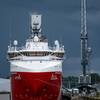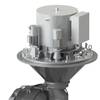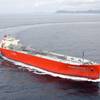The American Shipbuilding Association (ASA) represents the six largest shipbuilding companies in the United States: Avondale Industries, LA; Bath Iron Works, ME; Electric Boat, CT and RI; Ingalls Shipbuilding, MS; National Steel and Shipbuilding Company, CA; and Newport News Shipbuilding, VA and CA. These shipbuilders are the largest private manufacturing firms in five states and represent hundreds of thousands of supplier manufacturing jobs in 46 states.
On behalf of the American shipbuilding industry, it is my pleasure to share with the readers of Maritime Reporter & Engineering News the agenda and focus of the American Shipbuilding Association (ASA) as we enter the next century. In order to appreciate the significance of our agenda for the future, it is important to first state the tremendous challenges and technological transformation that our industry has undertaken to survive the 1990's, and to position ourselves to rebuild an American naval and commercial fleet unsurpassed in the world.
ASA shipbuilders are emerging from a seven-year period in which we have experienced the lowest rates of ship production since the height of the Great Depression of 1932. Naval orders have averaged only six ships per year and our orderbook for large oceangoing commercial ships has totaled only 15 since 1994. In the face of these low rates of ship production, ASA member companies have been forced to slash their workforce by 33 percent and re-engineer the way in which they design and build ships to enhance productivity, reduce cost, and continue to lead the world in the design and construction of the most technologically advanced ships. This on-going revolution has entailed tremendous investments in facilities, in technology, and in training our workforce to maximize the use of computers in the design and manufacturing process.
This is one of the most exciting and challenging eras of the American shipbuilding industry. As we enter the 21st Century, ASA shipbuilders represent the cutting edge of technology and are poised to demonstrate through the cost and quality of our products the quantum leap we have achieved. To fully realize and use this technological edge, a significant increase in the rate of naval and commercial ship production is essential. We must be able to operate at or near capacity to maximize the efficiencies of these new manufacturing investments and processes.
Sustaining a 300-Ship Navy
The Department of Defense and the Congress recognize that America and the Free World cannot allow the U.S. Navy's fleet to fall below a minimum of 300 ships and still meet the Nation's essential security commitments. To sustain even a 300-ship Navy, a stable build rate of 10 to 12 ships per year is required. In fiscal years 2001 through 2004, however, the Navy will request funding for only eight ships per year. This number must be increased or the Navy's fleet will continue its dangerous nose dive to 200 ships. The number of Virginia Class submarines procured per year will have to be doubled from one to two per year beginning in fiscal year 2003, and amphibious assault ships and destroyers will need to be added to the six-year building plan.
The American Shipbuilding Association will continue to stress to the Department of Defense and the Congress the importance of pursuing commercial ship acquisition and financing practices such as Multi-Year Procurement (MYP) contracting, incremental funding, and long-term leasing to make the Navy's required fleet of combatant and auxiliary ships more affordable. The Multi-Year Procurement Contract on the DDG-51 class of destroyers is saving the taxpayer $1.4 billion. This contracting method should continue for future destroyer acquisitions and be applied to the Virginia Class submarine program beginning in fiscal year 2003. Because large deck amphibious ships and aircraft carriers are bought in few numbers and take years to build, these ships should be bought in incremental payments throughout their construction rather than in their entirety before construction even begins. And lastly, the Navy should be encouraged to employ long-term lease financing of auxiliary and support ships through the National Defense Sealift Fund.
Congress has already begun to stress the need for greater Navy ship production and to encourage greater use of these cost saving acquisition practices. This year, Congress accelerated the construction of the LHD-8 amphibious assault ship and authorized that it be procured incrementally. The Conference Committee on the Defense Authorization Act also granted the Navy the authority to enter leasing contracts of 20 years or more for its auxiliary ships, and it extended the Multi-Year Procurement contract to the last six destroyers planned for procurement in fiscal years 2002 and 2003.
Whereas in the past, the Navy designed its ships in-house and then turned to industry to build them, the Navy has recognized that this process prolonged the design and construction time, limited the insertion of advanced technology, hampered innovation, and increased the cost to the taxpayer. With ASA shipbuilders now designing the Navy's 21st Century fleet, it is imperative that the Navy and Congress adequately budget for ship design early in the process to enable the industry to introduce into the fleet superior technologically designed and operating ships at a reduced risk -- and on an accelerated time schedule.
While Navy shipbuilding orders plummeted in the 1990's, ASA shipbuilders realized an increase in commercial business as a result of legislation enacted by Congress during that period. These were:
-- The Oil Pollution Act of 1990, which mandated the transportation of oil only in double hulled tankers by 2015 and required that single hulled tankers be phased out of service based on their age and weight.
-- The 1993 National Shipbuilding Initiative, which revived and amended the commercial Ship Financing
Guarantee Program and established an industry/government maritime technology cost share program called MARITECH.
-- The 1998 U.S.-Flag Cruise Ship Pilot Project to begin the development of an American cruise ship industry.
Since 1994, as a result of these initiatives, ASA shipbuilders have built or taken orders for the construction of 13 double hulled oil tankers and two, 2,000 passenger cruise ships. In the year 2000, ASA will work to expand upon these and other legislative initiatives to grow our commercial orderbook of environmentally safe tankers, cruise ships, container and other commercial ship types.
Commercial Ship Financing
To this end, ASA is urging the Administration and Congress to budget at least $50 million per year for the Title XI Ship Loan Guarantee Program in fiscal year 2001 and beyond. This loan guarantee fund must be replenished to enable ship buyers to secure commercial financing for the construction of more cruise ships, double hulled tankers, and fast cargo ships for which applications are either pending or expected to be submitted later this year.
Amendments to the Tax Code
Legislation is also expected to be introduced later this year to significantly grow the cruise ship construction market in the United States through changes in the tax code giving American shipbuilders tax parity with our foreign competitors. Suggested tax changes will include tax credits for builders of cruise ships; the payment of taxes on earnings derived from cruise ship construction only after completion of the contract; expansion of the Capital Construction Fund to include not only the non-contiguous trades but also the domestic point-to-point trades and "cruises to nowhere", and removal of deposits into Capital Construction Funds as an alternative minimum tax adjustment item.
National Defense Features Program
ASA will also be working with Congress and the Administration to urge robust funding for the National Defense Features Program (NDF) of the National Defense Sealift Fund. The NDF program was established to encourage the construction of dual-use ships in the United States by allowing the Department of Defense (DOD) to pay for the defense features built into a commercial ship provided that ship was made available to DOD to meet surge sealift requirements in time of national emergency. Studies by DOD have indicated that NDF surge sealift ships, because of their design and complement of a fully trained crew, would be more effective and two to three times cheaper than what DOD is currently paying to purchase used commercial ships, converting them, and maintaining them in a lay-up status while waiting to be called into duty. The existing reserve lay-up fleet numbers roughly 90 ships, which are old, outdated, and past their scrapping date.
This year, Congress expanded the NDF program in the Defense Authorization Bill to give the Navy the authority to pay up-front, in one lump sum payment, the cost of not only constructing the defense features, but also the private sector cost for the design, maintenance, and operation of the features over the life of the ship. This statutory change will eliminate the annual budget uncertainty that would otherwise be associated with payments owed by the government to the private sector for costs incurred annually and make participation in the program more attractive.
For example, FastShip, Inc. is interested in participating in the NDF program and has determined that the life time cost of defense features that would be designed into its 40-knot fast cargo ships would be $40 million per ship. If the NDF program is not funded by November of this year, however, FastShip will proceed with a pure commercial variant and the DOD will be denied the benefit of a fleet of militarily optimized dual-use ships. The Administration and Congress need to budget $300 million annually for the NDF program to provide for the construction of 7.5 NDF ships a year to replace the existing inactive fleet of reserve ships that are in dire need of replacement.
Extended Lease Authority for DOD Auxiliary Ships
ASA is also optimistic that in the year 2000 Congress will expand on its initiative to encourage the Navy to enter long-term leasing contracts for its auxiliary ships by directing the Office of Management and Budget to score such leases as operating rather than capital leases. This is critical because a "capital lease", under current government budget rules and anomalies, dictates that the cost of the entire term of the lease be scored in the first year in which the lease contract is signed as opposed to an "operating lease", which is scored based on the actual annual cost of the lease. These quirky Washington scoring rules could equate to a budget difference of $20 million versus more than $200 million per year for the lease of a ship's service. The latter of course would nullify any financial benefit to the DOD of leasing versus buying.
Although the United States is no longer engaged in a stand-off against another major super power, the world remains a very dangerous place. With forward bases closed to American troops and airplanes, American naval forces are being called upon as never before. In fact, U.S. naval forces have responded to 300 times the number of crisis as they did during the Cold War -- and they are doing it with half the size of their Cold War fleet. Because no other military service offers the responsiveness, flexibility, and firepower of the U.S. Navy/Marine Corps team, the missions and responsibilities of the Navy will only grow. To meet these 21st Century challenges, the Nation will require a larger fleet of the most technologically advanced and versatile ships in the world. Only American shipbuilders have the capability to build this fleet. This fact intricately links the future security of the United States with the strength of the American shipbuilding industry.
Subscribe for
Maritime Reporter E-News
Maritime Reporter E-News is the maritime industry's largest circulation and most authoritative ENews Service, delivered to your Email five times per week










